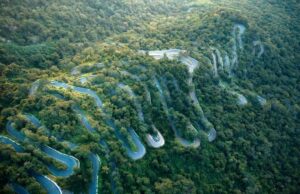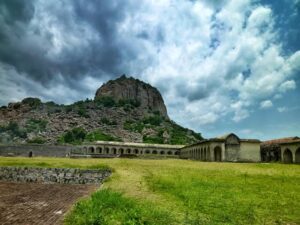Tamil Nadu is renowned for its ancient temples and bustling cities, but it also has numerous hidden gems that offer a mix of natural beauty, history, and tranquility. Here’s a list of Top 5 Hidden Gems in Tamil Nadu that you must explore.
#1 Chettinad Mansions (Karaikudi)
Explore the grandeur of Chettinad architecture, with its intricately designed mansions, antique furniture, and unique culinary heritage. are iconic for their grandeur, intricate design, and historical significance. These mansions were built by the Chettiar community, a wealthy merchant and banking class, during the 19th and early 20th centuries. They reflect a unique blend of local tamil architecture and global influences, as the Chettiars traveled extensively for trade.

A Heaven of History and Culture
Nestled in the heart of Sivagangai district in Tamil Nadu, India, Chettinad boasts a captivating history and stunning architectural marvels. Today, these mansions are a testament to the region’s rich heritage and offer a unique tourism experience.
Explore the Architectural Splendor
Chettinad mansions are characterized by their intricate facades, grand courtyards, and spacious interiors. Each mansion boasts a unique blend of traditional Tamil, European, and Indian aesthetics. Tourists can wander through these architectural wonders, marveling at the ornate entrances, polished verandahs, and imposing pillars.
Step into History and Opulence
The interiors of the mansions are just as captivating as the exteriors. Visitors can step inside to admire the lavish furnishings, antique chandeliers, and painted ceilings. The rooms exude a sense of grandeur and opulence, offering a glimpse into the lifestyle of the wealthy Chettiars.
Discover Local Crafts and Heritage
Chettinad is also home to various traditional crafts. Tourists can visit workshops where skilled artisans demonstrate the art of weaving silk sarees, making pottery, or carving intricate woodwork. This provides an opportunity to learn about the region’s cultural heritage and support local businesses.
Recommended Tourist Attractions
- Kanadukathan Palace: The largest and most opulent Chettinad mansion, it is a testament to the architectural prowess of the region.
- Aayiram Jannal Veedu: Known as the “House of a Thousand Windows” this mansion features intricate carvings and a vast collection of antiques.
- Viswanatha Chettiar Palace: Built in the late 19th century, this palace is known for its elegant interiors and stunning frescoes.
Tips for Visitors
- Plan your visit during the winter months (October-March) for pleasant weather.
- Allow ample time to explore the mansions, as there’s much to see and appreciate.
- Dress appropriately when visiting temples or religious sites.
#2 Kolli Hills
Kolli Hills is a captivating hill station that offers a blend of natural beauty, cultural heritage, and adventure. Its lush hills, cascading waterfalls, ancient temples, and thrilling activities make it a must-visit destination for nature lovers, history buffs, and adventure enthusiasts alike. Kolli Hills also known as “Mountain of Death” is a visually stunning hill range with numerous waterfalls, lush forests, and historical temples.

An Enchanting Hill Station in Tamil Nadu
Nestled admist the Eastern Ghats in the Namakkal district of Tamil Nadu, Kolli Hills is a picturesque hill station that allures nature lovers and adventure enthusiasts alike. With its verdant hills, cascading waterfalls, and ancient temples, Kolli Hills offers a serene and rejuvenating experience.
Scenic Beauty
The hills of Kolli are a vibrant tapestry of nature’s artistry. Rolling green mountains, dense forests, and shimmering streams create a breathtaking panorama. The highest point in the hills is the Arappaleeswarar Temple, which offers panoramic views of the surrounding landscape.
Cascading Waterfalls
Kolli Hills is home to several beautiful waterfalls that add to its allure. The Agaya Gangai Falls known as the “Niagara Falls of South India” is a majestic sight, cascading from a height of 300 feet. Other noteworthy waterfalls include the Perumbar Falls, the Panchakara Falls, and the Coral Falls.
Pristine Rivers
The Kolinji River and the Kaveri River originate in Kolli Hills. These crystal-clear rivers meander through the hills, creating tranquil pools and providing opportunities for swimming and boating.
Adventure Activities
Kolli Hills offers a range of adventure activities for thrill-seekers. Paragliding, trekking, and mountain biking are popular pastimes here. The hills also have several hilltop viewpoint that offer breathtaking views for photography and scenic walks.
How to Get There
Kolli Hills is located 120 kilometers from Salem and 350 kilometer from Chennai. The nearest airport is Thiruchirapalli, which is 70 kilometers away. Buses and taxis are available from major cities to reach Kolli Hills
Best Time to Visit
Kolli Hills is a year-round destination, but the best time to visit is during the monsoon season (October to December) when the waterfalls are at their peak. The hills are also pleasant during the winter months.
#3 Gingee Fort
Gingee Fort, also known as Senji Fort, is a historic fortification located in the Villupuram district of Tamil Nadu, India. It is widely regarded as one of the most impregnable forts in India and is often referred to as the “Troy of the East”. The fort is spread over three hillocks–Rajagiri, Krishnagiri, and Chandrayandurg, with a unique triangular structure. It is a popular tourist destination for history buffs, adventures, and nature lovers.

A Historical and Architectural Marvel
Nestled amidst the rolling hills of Tamil Nadu, India. Gingee Fort is a colossal fortress steeped in centuries of history and architectural brilliance. Recognized as one of the most impregnable forts in South India, it stands as a testament to the strategic and military prowess of past civilizations.
Historical Significance
Gingee’s origins can be traced back to the 2nd century BC, when it was known as Senji Malai. Over the centuries, it witnessed numerous battles and sieges, passing through the hands of numerous dynasties including the Pallavas, Cholas, and Marathas. In 1698, the fort was conquered by the Mughal Empire under Aurangzeb, who made it a major garrison.
Architectural Splendor
Gingee Fort is renowned for its complex and elaborate architecture. It comprises the three main citadels- Rajagiri, Krishnagiri, and Chandrayandurg spread across multiple hills. Each citadels has its own unique fortifications, gateways, and structures, showcasing a blend of Hindu and Islamic architectural styles.
- Rajagiri Citadel: The highest and most fortified of the three citadels, Rajagiri houses the Raja Mahal (Royal Palace), Rani Mahal (Queen’s Palace), and a temple dedicated to Lord Vishnu.
- Krishnagiri Citadel: Located in the center, Krishnagiri features a large granary, stables, and a temple to Lord Shiva.
- Chandrayandurg Citadel: The largest and most elaborately fortified, Chandrayandurg boasts an extensive network of tunnels, dungeons, and defense systems.
Tourist Attractions
Gingee Fort is a popular tourist destination, offering a glimpse into the rich history and architectural heritage of India. Visitors can explore the following attractions
- Fortification: Explore the intricate fortifications, including the massive ramparts, gateways, and bastions.
- Temples: Visit the ancient temples dedicated to Lord Vishnu and Lord Shiva, adorned with intricate carvings and sculptures.
- Royal Palace: Step inside the grand Raja Mahal and Rani Mahal, once home to the rulers of Gingee.
- Granary: Witness the enormous granary used to store provisions for the garrison and population during times of siege.
- Tunnels and Dungeons: Discover the secret tunnels and dungeons that were used for military and defense purposes.
How to Get There
Gingee Fort is located approximately 160 kilometers(100 miles) southwest of Chennai. Visitors can reach the fort by car or public transport. The nearest railway station is Tindivanam, which is connected to major cities in India.
Tips For Visitors
- Allows at least half a day to fully explore the fort.
- Wear comfortable shoes as you will be doing a lot of walking.
- Carry a plenty of water, especially during the summer months.
#4 Tharangambadi (Tranquebar)
Tharangambadi also known as Tranquebar, is a picturesque coastal town in Tamil Nadu with a rich history and cultural legacy. Located in the Nagapattinam district, this tranquil destination offers a unique blend of Danish colonial heritage, Tamil culture, and serene natural beauty. Known as the “Land of the Singing Waves” Tharangambadi is perfect for travelers seeking history, architecture, and peace.

Historical Significance
- Danish Settlement (1620-1845): Tharangambadi became a Danish trading post in 1620 when Denmark established its presence in India. The town served as a hub for trade and missionary activities during the Danish rule.
- Missionary History: It is the birthplace of Protestantism in India, thanks to Bartholomaus Ziegenbalg, who set up the first Protestant Church and Tamil Printing press in the 18th century.
- Tamil Maritime Legacy: Even before Danish influence, Tharangambadi was an important port town during the Chola and Pandya dynasties.
Tourist Attractions
- Fort Dansborg: A prominent Danish fort built in 1620, it stands as the second-largest Danish fort in the world. The fort houses a museum with artifacts, documents, and paintings from the Danish era.
- Tranquebar Beach: A serene and clean beach perfect for relaxation and enjoying sunsets, It offers stunning views of colonial buildings lining the coast.
- Zion Church: Built in 1701, it is the oldest Protestant church in India, Known for its Danish architecture and historical significance.
- New Jersalem Church: Constructed in 1718 by Ziegenbalg, it reflects a blend of European and Tamil architectural styles.
- Masilamani Nathar Temple: A 13th-century temple built by the Pandyas, its unique coastal location adds to its charm.
- The Governor’s Bungalow: A colonial-era mansion converted into a heritage hotel, Offers a glimpse into the luxurious lifestyle of Danish officials.
- The Town Gate: Known as the Landporten, this gate served as the entry point to the fortified town during Danish rule.
Things to Do
- Heritage Walks: Stroll along King’s Street and Quees’s Street to admire colonial buildings and traditional Tamil homes.
- Cycling Tours: Explore the quiet streets of Tharangambadi on a bicycle.
- Learn Tamil History: Visit the Danish Governor’s residence and nearby museums to learn about the region’s colonial and maritime history.
- Relax at the Beach: Spend a peaceful day at the beach, enjoying the sound of waves and cool sea breeze.
Best Time to Visit
November to March is ideal, with pleasant weather.
How to Get There
- Nearest airport is Thiruchirapalli (160 km).
- Karaikal Railway Station (15 km) is the nearest railhead.
- Well-connected to Chennai (270 km) and Puducherry (120 km) via NH 32.
Tips For Visitors
- Take Comfortable footwear, sunscreen, and a camera for capturing the colonial charm.
- Bungalow on the beach A luxurious heritage hotel overlooking the sea.
- Budget hotels are available in nearby towns like Karaikal.
#5 Pichavaram Mangrove Forest
Pichavaram is a perfect gateway for those looking to immerse themselves in nature’s tranquility. Whether it’s the thrill of navigating narrow waterways, the joy of birdwatching, or the sheer beauty of the mangroves, Pichavaram offers an unforgettable experience. It’s also an excellent destination for promoting eco-tourism and appreciating one of nature’s most delicate ecosystems.

Tourist Attractions
- Biodiversity Hotspot: Home to mangrove trees that thrive in brackish waters, Rich in flora and fauna, including exotic bird species, fish, and crabs.
- Boating Through the Mangroves: The main attraction is exploring the dense mangrove forests by rowboats or motorboats, Navigate through narrow canals with overhanging roots and branches for a magical experience.
- Wildlife Spotting: A paradise for birdwatchers with sightings of kingfishers, herons, egrets, and migratory birds like flamingos, Aquatic life includes prawns, crabs, and mollusks.
- Adventure Activities: Kayaking and canoeing options are available for thrill-seekers, Ideal for eco-tourism and exploring nature trails.
Things to Do
- Explore by Boat: Choose a guided boat tour to explore hidden waterways and learn about the mangroves.
- Birdwatching: Visit during the migratory bird season (November to January) for a chance to see rare species.
- Photography: Capture the stunning reflections, green corridors, and unique wildlife.
- Nature Walks: Walk around the edges of the forest to experience its beauty up close.
Best Time to Visit
November to February is the ideal time, with cooler weather and migratory birds.
Timing and Fees: Open from 8:00 AM to 5:00 PM, Nominal entry and boating charges apply.
